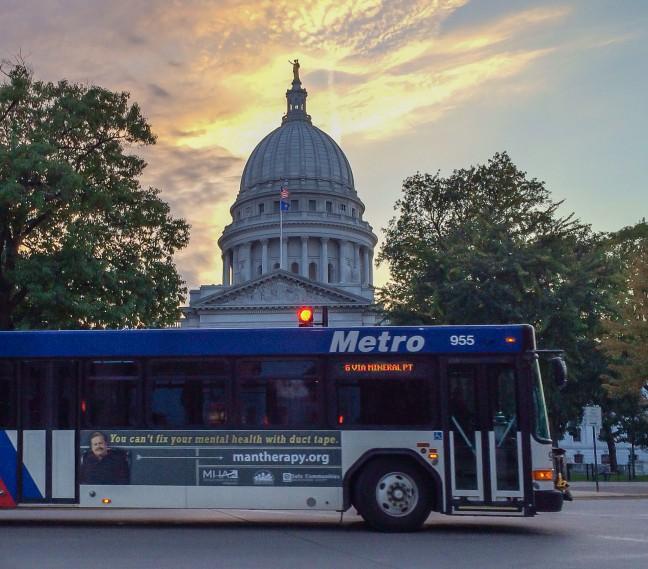Madison Metro Transit will redesign its bus system by August 2023 to better meet the needs of Madison-area residents and businesses by increasing access and frequency, decreasing travel times and improving the experience of transit riders.
The current system focuses on peak hour routes, with less service available during midday, evenings and weekends. It also centers around five hubs in the city — the Capitol and four transfer points, according to the City of Madison website.
According to Metro Transit transportation planner and project lead Mike Cechvala, the redesign was put into the city budget in 2020 and the project started in early 2021, though Metro Transit considered the redesign for years.
“The current bus system has not been significantly remodeled in over 20 years,” Cechvala said. “We expect to have the new network entirely in place by August of 2023.”
Right now there are many buses on many streets, but there are relatively few trips anyone could take where the fastest bus comes more often than every 30 minutes, according to the Metro Transit Executive Summary.
According to Cechvala, one of the main goals is to simplify the service, which will cut down on overlapping routes and replace them with ones that serve the city more efficiently.
“It just takes too long to get anywhere. People take trips across town and it takes them over an hour,” Cechvala said. “Decreasing travel time will reduce vehicle miles and encourage a shift from cars to buses.”
According to the Metro Transit Executive Summary, downtown Madison is the largest destination for buses, but most people aren’t traveling downtown.
Cechvala said once implemented, the new system will encourage ridership throughout the city.
“A more efficient system will hopefully increase ridership, which has been slowly declining after a peak around six years ago,” Cechvala said. “Due to COVID-19, this past year has been especially difficult for Metro Transit.”
If implemented, the plan would also have notable environmental benefits, including reduced pollution and emissions. Using public transportation can help individuals lower their personal carbon footprint and reduce their transportation-related emissions, according to National Express Transit.
Metro Transit decreased service by over 20% since the pandemic and university-related ridership dropped the most, according to the Metro Transit Executive Summary.
Additionally, the ridership change is unequal, with ridership in peripheral low-income areas and communities of color dropping the least because these populations tend to have higher numbers of essential workers.
According to Cechvala, Metro Transit’s new plan aims to better serve disadvantaged Madison communities.
“Easier and more frequent service could improve equity for those neighborhoods,” Cechvala said.
The new system will have to make several key decisions, such as ridership versus coverage, walking versus waiting, one-seat rides versus transfers and peak versus all-day needs.
The Metro Transit Network Redesign Project published a Transit Choices Survey on the City of Madison website to gauge public opinion on the redesign.
The survey includes questions about what Metro Transit should improve, what areas in Madison the system should cater to more and what the completed redesign should look like.
According to Cechvala, responses coincided with the goals of the new system.
“Most respondents indicated that they want increased efficiency and shorter travel times, aligning with Metro Transit’s goals for the redesign,” Cechvala said. “Many participants also indicated their approval for the redesign plans.”
The redesign will also include a robust community engagement process throughout each phase using a range of tools including surveys, workshops, public meetings, focus groups and other events, according to the Metro Transit website.
According to Metro Transit Marketing and Customer Service Manager Mick Rusch, public hearings will allow community members to discuss their opinions officially before any changes are made.
“City transportation groups will supervise the project,” Rusch said. “The Transportation Policy and Planning Board will oversee long-range policies, while the Transportation Commission will approve any changes to routes, schedules and fares.”
Redesigning the bus system will allow Metro Transit to live up to its classification as a high-performing system, similar to bus systems in larger cities, according to the Wisconsin State Journal.
According to Cechvala, the plan will be flexible to best fit the needs of Madison residents.
“Metro Transit plans to implement some changes in August 2022, and continue to make changes throughout the following year,” Cechvala said. “So far, the people that we’ve talked to are supportive.”
A full project timeline can be found in the Metro Transit Executive Summary.


